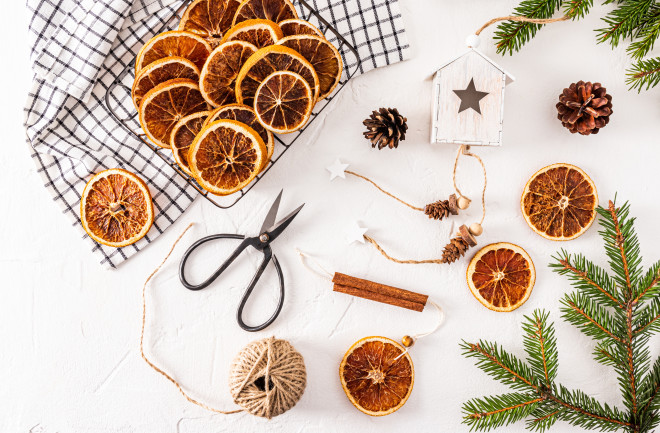Decorating a Modern Christmas tree for the holidays is a tradition that stems from Germany during the Medieval Era. Since then, tree trimming decorations have evolved from hanging fruit, glass orbs, natural wooden decorations, candles, shatter-proof plastic ornaments, and plastic lights.
In recent years, more people have returned to the holidays' natural roots as eco-friendly decorations flood social media. The decorations are cost-effective and easy to make. Check out how to make your holidays more sustainable without skimping on the cheer.
1. Edible Garlands and Evergreen Wreaths
Decking the halls with greenery like holly and fir has a long history dating to Yule, a pre-Christian holiday celebrating the Winter solstice. Pagans used branches of evergreen trees to adorn their homes and bring cheer during the time with less sunlight.
Early Christians decorated their homes with holly and ivy in the Middle Ages as a symbol of everlasting life and the return of warmer seasons, according to English Heritage.
Evergreen trees, garlands, and wreaths were also used as symbols of eternal life by ancient Egyptians, Chinese culture, and Hebrews, according to Britannica.
How Do I Make an Edible Garland?
An easy way to give indoor holiday decorations a crafted and earth-friendly look is to hang a garland made from twine, evergreen branches, dried fruits, popcorn, and cinnamon sticks. Garlands can quickly look even more festive by adding strung popcorn and dried oranges.
Decorating with popcorn dates to 1842, according to America's Favorite Gourmet Popcorn. During this time, the first Christmas tree in Williamsburg, Virginia, was decorated with paper decorations and popcorn strings.
The translucent look of the oranges brings shimmer and color. To add more color, you can also make patterns with cranberries. After the season is over, the garland is easily composted.
Read More: How to Make Sure Your Holiday Decorations Are Safe for Your Pets
2. Plastic-Free Ornaments
Traditionally, evergreens were decorated with glass-blown ornaments after the custom began in Germany. By the 19th century, glass ornaments imported from Germany and Bohemia appeared for sale in the U.S.
One way to make your tree sparkle and more eco-friendly is to swap out plastic baubles for glass, wooden, or felt ornaments. If you want to go for an even more crafted look, you can hunt for twigs outside and make star-shaped ornaments.
How to Make a Twig Star Ornament
Gather five flexible twigs from your expedition outside. Cut each of the twigs to the same length with scissors. Take two of the twigs and tie the thick ends of them together with string or twine. Once secured, pull them apart slightly to create a point.
Next, tie another twig to the bottom of the right twig and adjust the point to match the other point you just made. Weave the 4th twig to connect to the last twig but under and over the first two twigs to create one of the star's points. Then, add the previous twig, weaving it through to complete the star and tie. (Instructions adapted from Lovely Greens.)
3. Paper Decorations
After Queen Victoria and Prince Albert dazzled the British and popularized the tradition of a Christmas Tree, Victorians decorated their trees with scraps of paper and small trinkets.
According to the Des Plaines History Center, decorations like paper chains, paper fans, paper snowflakes, and fancy paper cones that held treats like small nuts and candy were typical on Victorian trees. Paper decorations were common during this era because paper production increased and was readily available in stores. When missionaries from the West brought Christmas trees to Japan and China, the evergreens were decorated with elaborate paper decorations in the 19th and 20th centuries.
Other paper-crafted ornaments called dresdens date back to 1880 to 1910. Artists made these ornaments from embossed cardboard, each rolled and crafted to look like all kinds of shapes like suns, stars, polar bears, moons, alligators, boats, and musical instruments, to name a few. You can hand-craft your paper ornaments by folding together paper to make origami or holding paper to make stars, cones, or fans.
Read More: Real Or Artificial? How To Choose The Most Sustainable Christmas Tree
4. Reused and Thrifted Decorations
In the U.K. alone, house waste during the festive season increases by 30 percent. For Americans, each one produces 25 percent more waste during the holiday season — or about one million tons of extra trash produced weekly.
Some ways to reduce your carbon footprint this holiday season are to repurpose, thrift, reuse, or exchange old Christmas decorations with friends and family.
5. LED Lights
Switching to LED lights to illuminate a tree can save some energy. According to CommercialWaste, on average, Christmas trees are left on for 10 hours a day. Currently, incandescent bulbs use enough energy to fill up five balloons with CO2. Switching to LED lights uses up to 80 to 90 percent less energy than incandescent bulbs.
Read More: How to Save Energy: 5 Tips to Save Money and Stay Warm

